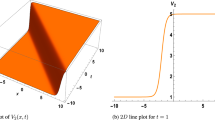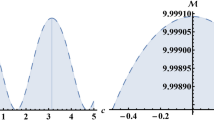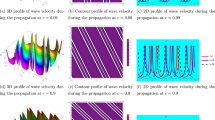Abstract
This study explores analytical and approximate explicit solutions for the generalized Hietarinta-type equation, denoted as (\({{\mathcal {G}}}{{\mathcal {H}}}\)), in the context of (2+1) dimensions. This investigation utilizes contemporary computational and numerical techniques, including the Khater II technique, He’s variational iteration method, and the septic–B–spline scheme. The \({{\mathcal {G}}}{{\mathcal {H}}}\) equation serves as a mathematical representation of wave propagation on water surfaces, accounting for both gravity and surface tension effects. In fluid dynamics, different wavelengths of waves are associated with distinct phase velocities and frequencies. This research introduces innovative solitary wave solutions, visually depicted through figures, and rigorously assesses their computational accuracy using state-of-the-art numerical methods. The stability of these solutions is scrutinized through the characteristics of the Hamiltonian system. The solutions are reintroduced into the original \({{\mathcal {G}}}{{\mathcal {H}}}\) model using Mathematica 13.1 software to validate the obtained results. This study holds significant importance in mathematical modeling and fluid dynamics because it explores the \({{\mathcal {G}}}{{\mathcal {H}}}\) equation in (2+1) dimensions. The \({{\mathcal {G}}}{{\mathcal {H}}}\) equation is a vital tool for modeling wave propagation on water surfaces, encompassing the interplay of gravity and surface tension, a phenomenon with broad practical applications. Additionally, the study contributes to the field by conducting a stability analysis of these solutions, providing insights into their dynamic behavior and long-term evolution.



Similar content being viewed by others
Data availibility
The data that support the findings of this study are available from the corresponding author upon reasonable request.
References
Huang, Y., Zhu, Y., Zhao, Y., Wu, L., Zhang, L., Zhang, Y., Wu, J., Tan, F.: Experimental investigation for pulsed laser nitriding of metals. Opt. Laser Technol. 157, 108661 (2023). https://doi.org/10.1016/j.optlastec.2022.108661
Ma, W.-X., Zhou, Y.: Lump solutions to nonlinear partial differential equations via hirota bilinear forms. J. Differ. Equ. 264(4), 2633–2659 (2018)
Khater, M.M.A.: Computational simulations of propagation of a tsunami wave across the ocean. Chaos Solitons Fractals 174, 113806 (2023)
Alquran, M., Najadat, O., Ali, M., Qureshi, S.: New kink-periodic and convex-concave-periodic solutions to the modified regularized long wave equation by means of modified rational trigonometric-hyperbolic functions. Nonlinear Eng. 12(1), 20220307 (2023)
Alquran, M.: New interesting optical solutions to the quadratic-cubic schrodinger equation by using the kudryashov-expansion method and the updated rational sine-cosine functions. Opt. Quant. Electron. 54(10), 666 (2022)
Giammarinaro, B., Tsarsitalidou, C., Hillers, G., de Rosny, J., Seydoux, L., Catheline, S., Campillo, M., Roux, P.: Seismic surface wave focal spot imaging: numerical resolution experiments. Geophys. J. Int. 232(1), 201–222 (2023). https://doi.org/10.1093/gji/ggac247
Das, U., Pan, C.-J., Yang, S.-S.: Evolution of individual equatorial atmospheric Kelvin waves in the stratosphere from FORMOSAT-7/COSMIC-2 temperatures, terrestrial. Atmos. Ocean. Sci. 33(1), 4 (2022). https://doi.org/10.1007/s44195-022-00006-2
Khater, M.M.A.: Soliton propagation under diffusive and nonlinear effects in physical systems; (1+1)-dimensional MNW integrable equation. Phys. Lett. A 480, 128945 (2023)
Alquran, M., Alhami, R.: Analysis of lumps, single-stripe, breather-wave, and two-wave solutions to the generalized perturbed-Kdv equation by means of hirota’s bilinear method. Nonlinear Dyn. 109(3), 1985–1992 (2022)
Alquran, M.: Classification of single-wave and bi-wave motion through fourth-order equations generated from the Ito model. Phys. Scripta 98, 085207 (2023)
Li, J.H., Yin, H.M., Chiang, K.S., Chow, K.W.: Fermi-Pasta-Ulam-Tsingou recurrence in two-core optical fibers. Phys. D 441, 133501 (2022). https://doi.org/10.1016/j.physd.2022.133501
Alquran, M., Ali, M., Gharaibeh, F., Qureshi, S.: Novel investigations of dual-wave solutions to the kadomtsev-petviashvili model involving second-order temporal and spatial-temporal dispersion terms. Partial Differ. Equ. Appl. Math. 8, 100543 (2023)
Alquran, M., Ali, M., Jadallah, H.: New topological and non-topological unidirectional-wave solutions for the modified-mixed Kdv equation and bidirectional-waves solutions for the Benjamin ono equation using recent techniques. J. Ocean Eng. Sci. 7(2), 163–169 (2022)
Kusumoto, S., Imai, K., Hori, T.: Time difference between the 1854 CE Ansei-Tokai and Ansei-Nankai earthquakes estimated from distant tsunami waveforms on the west coast of North America. Prog. Earth Planet Sci. 9(1), 2 (2022). https://doi.org/10.1186/s40645-021-00458-z
Khater, M.M.A.: Horizontal stratification of fluids and the behavior of long waves. Eur. Phys. J. Plus 138(8), 715 (2023)
Zhang, L., Yao, Y., Li, X., Chen, N.-K., Bai, C., Yang, F., Tian, Z., Ren, Y., Wang, M.: Dissipative dual-wavelength pulses synchronously mode-locked in a compact fiber laser. Opt. Laser Technol. 156, 108582 (2022). https://doi.org/10.1016/j.optlastec.2022.108582
Jaradat, I., Alquran, M.: Construction of solitary two-wave solutions for a new two-mode version of the Zakharov-Kuznetsov equation. Mathematics 8(7), 1127 (2020)
Saravanan, M., Priyadharshini, R.S., Praveen, B.: Bulk growth and portrayal investigation of 2,4,6-trinitrophenol crystal for nonlinear optical, electro-optic appliances. Opt. Laser Technol. 156, 108556 (2022). https://doi.org/10.1016/j.optlastec.2022.108556
Khater, M.M.A.: Characterizing shallow water waves in channels with variable width and depth; computational and numerical simulations. Chaos Solitons Fractals 173, 113652 (2023)
Ge, P., Wang, Z., Tu, X., Lu, M., Fan, G., Xiao, B.: A dual-band frequency scanning antenna based on spoof SPPs transmission line. Opt. Commun. 524, 128743 (2022). https://doi.org/10.1016/j.optcom.2022.128743
Zhang, X., Shi, Y., Xu, J., Ouyang, Q., Zhang, X., Zhu, C., Zhang, X., Chen, Y.: Identification of the intrinsic dielectric properties of metal single atoms for electromagnetic wave absorption. Nano-Micro Lett. 14(1), 27 (2022). https://doi.org/10.1007/s40820-021-00773-6
Khater, M.M.A.: Advancements in computational techniques for precise solitary wave solutions in the (1 + 1)-Dimensional Mikhailov-Novikov-Wang equation. Int. J. Theor. Phys. 62(7), 152 (2023)
Guo, S., Ding, H., Li, Y., Feng, H., Xiong, X., Su, Z., Feng, W.: A hierarchical deep convolutional regression framework with sensor network fail-safe adaptation for acoustic-emission-based structural health monitoring. Mech. Syst. Signal Process. 181, 109508 (2022). https://doi.org/10.1016/j.ymssp.2022.109508
Zhou, Z., Li, H., Sun, W., He, Y., Liberal, I., Engheta, N., Feng, Z., Li, Y.: Dispersion coding of ENZ media via multiple photonic dopants. Light Sci. Appl. 11(1), 207 (2022). https://doi.org/10.1038/s41377-022-00892-8
Li, W., Hu, X., Wu, J., Fan, K., Chen, B., Zhang, C., Hu, W., Cao, X., Jin, B., Lu, Y., Chen, J., Wu, P.: Dual-color terahertz spatial light modulator for single-pixel imaging. Light Sci. Appl. 11(1), 191 (2022). https://doi.org/10.1038/s41377-022-00879-5
Aigner, A., Dawes, J.M., Maier, S.A., Ren, H.: Nanophotonics shines light on hyperbolic metamaterials. Light Sci. Appl. 11(1), 9 (2022). https://doi.org/10.1038/s41377-021-00688-2
Cai, C., Zhou, J., Wang, K., Xu, D., Wen, G.: Metamaterial plate with compliant quasi-zero-stiffness resonators for ultra-low-frequency band gap. J. Sound Vib. 540, 117297 (2022). https://doi.org/10.1016/j.jsv.2022.117297
Huet, M., Geiger, L.: Modeling of indirect combustion noise through a stator. J. Sound Vib. 540, 117296 (2022). https://doi.org/10.1016/j.jsv.2022.117296
Osika, M., Ziaja-Sujdak, A., Radecki, R., Cheng, L., Staszewski, W.J.: Nonlinear modes in shear horizontal wave propagation-analytical and numerical analysis. J. Sound Vib. 540, 117247 (2022). https://doi.org/10.1016/j.jsv.2022.117247
Gerus, S.V., Annenkov, A.Y., Lock, E.H.: Experimental visualization of dispersion characteristics of backward volume spin wave modes. J. Magn. Magn. Mater. 563, 169747 (2022). https://doi.org/10.1016/j.jmmm.2022.169747. arXiv:2204.08293
Potrivitu, G.-C., Xu, S.: Evidence of the ionization instability and ion acoustic turbulence correlation in sub-ampere hollow cathodes. J. Electric Prop. 1(1), 6 (2022). https://doi.org/10.1007/s44205-022-00005-y
Dhaouadi, F., Dumbser, M.: A first order hyperbolic reformulation of the Navier-Stokes-Korteweg system based on the GPR model and an augmented Lagrangian approach. J. Comput. Phys. 470, 111544 (2022). https://doi.org/10.1016/j.jcp.2022.111544
Dasgupta, S., Karmakar, P.K.: Acoustic modal instability in relativistic gyromagnetoactive ultra-dense quantum fluids. J. Astrophys. Astron. 43(2), 60 (2022). https://doi.org/10.1007/s12036-022-09836-5
Ashish, Singh, S.: Dispersive features of electrostatic waves in bounded quantum plasma under the effect of ionization. J. Astrophys. Astron. 43(2), 59 (2022). https://doi.org/10.1007/s12036-022-09857-0
Bharti, S.P., Singh, S.: Studies of growing waves in Hall thruster beam plasma under the influence of electron temperature. J. Astrophys. Astron. 43(2), 47 (2022). https://doi.org/10.1007/s12036-022-09834-7
Das, S., Karmakar, P.K.: Non-planar magnetoactive GES-based solar plasma stability. J. Astrophys. Astron. 43(2), 44 (2022). https://doi.org/10.1007/s12036-022-09838-3. arXiv:2207.14618
He, Y.-X., Wang, S., Xi, B., Tang, G., Yin, H., Zhao, L., Sun, C., Ma, X.: Role of pressure and pore microstructure on seismic attenuation and dispersion of fluid-saturated rocks: laboratory experiments and theoretical modelling. Geophys. J. Int. 231(3), 1917–1937 (2022). https://doi.org/10.1093/gji/ggac286
Zhang, Y., Zhang, H.: Excitation of Rayleigh and Love waves in double-layered half-space. Geophys. J. Int. 231(3), 1672–1687 (2022). https://doi.org/10.1093/gji/ggac276
Talebi, M., Sadeghi, E., Zahedifar, M., Harooni, S.: Synthesis, structural characteristics and thermoluminscence features of KCl: Mn and KCl: Ce phosphors. Nucl. Inst. Methods Phys. Res. B 530, 29–38 (2022). https://doi.org/10.1016/j.nimb.2022.09.007
Batwa, S., Ma, W.-X.: Lump solutions to a generalized Hietarinta-type equation via symbolic computation. Front. Math. China 15(3), 435–450 (2020)
Kiliç, S.ŞŞ: Multi and breather wave soliton solutions and the linear superposition principle for generalized Hietarinta equation. Int. J. Mod. Phys. B 36(02), 2250019 (2022)
Khater, M.M.: Nonparaxial pulse propagation in a planar waveguide with Kerr-like and quintic nonlinearities; computational simulations. Chaos Solitons Fractals 157, 111970 (2022)
Khater, M.M., Alabdali, A.M.: Faster and slower soliton phase shift: oceanic waves affected by earth rotation. Mathematics 9(24), 3223 (2021)
Acknowledgements
I greatly thank the journal staff (editors and reviewers) for their support and help.
Funding
No fund has been received.
Author information
Authors and Affiliations
Contributions
All the study has been done by the author himself.
Corresponding author
Ethics declarations
Conflict of interest
The authors declare that they have no competing interests.
Additional information
Publisher's Note
Springer Nature remains neutral with regard to jurisdictional claims in published maps and institutional affiliations.
Appendix
Appendix
Here, we explain the highlights of the above–employed analytical (Khater II) method and approximate (variational iteration) method.
1.1 Khater II Method
This section gives the Khater II method’s headlines where it is first time to be used as follows:
Assume the following form for the equation of nonlinear evolution:
where \({\mathcal {G}}={\mathcal {G}}(x,t)\) is a polynomial of \({\mathcal {U}}(x,t)\) and its partial derivatives wherein the highest order derivatives and nonlinear terms are concerned. The main steps of the employed method are as follows
Step 1 The traveling wave transformation
converting Equation (A1) into the following ODE
where \({\mathcal {C}}\) is a polynomial in \({\mathcal {U}}(\xi )\) and its total derivatives, wherein \(\varphi ^{\prime }(\xi )=\frac{d \varphi }{d \xi }\).
Step 2We suppose the solution of (A3) is of the form
where \(a_{i},\, b_{i}\,(i=0,1,2,3, \ldots ,n)\) are arbitrary constants to be determined, such that \(a_{n} \ne 0\), and \(\phi (\xi ), \, f(\xi )\) satisfies the following equation
where \(\delta \) is arbitrary constant.
Step 3 We determine the positive integer n come out in the suggested general solution by considering the homogeneous balance between the highest order derivatives and the highest order nonlinear terms occurring in (A3) as following
Step 4 We compute all the required derivatives \({\mathcal {V}}^{\prime },\, {\mathcal {V}}^{\prime \prime },\, \ldots \), and substitute (A4) and the derivatives into (A3) and then we account for the function \(\phi (\xi ), \, f(\xi )\). As a result of this substitution, we obtain a polynomial of \(\phi (\xi ), \, f(\xi )\) and its derivatives. In this polynomial, we equate all the coefficients to zero. This procedure yields a system of equations whichever can be solved to find \(a_k\) and \(\phi (\xi ), \, f(\xi )\).
1.2 He’s Variational Iteration Method
Here is a general nonlinear differential equation, which illustrates the basic concept of He’s variational iteration method:
where \({\mathcal {L}},\, {\mathcal {N}},\, g(x,t)\) are respectively describe a linear operator, a nonlinear operator, and a known analytical function. According to the variational method, a correction functional can be constructed as follows:
In this case, \(\varsigma \) denotes a general Lagrange multiplier that can be identified optimally using variational theory, and \(\tilde{{\mathcal {U}}}_{\rho }\) represents a restricted variation, i.e. \(\delta \, \tilde{{\mathcal {U}}}_{\rho }=0\). The stationary conditions
This in turn gives
Using He’s variational iteration technique to the investigated model for investigating the model’s approximate solution, gets the following values of the analytical, numerical, and absolute difference between these two values.
1.3 Septic–B–Spline Scheme
Based on the septic B–spline, the suggested solution of the obtained ordinary differential equation (3) is given as follow
where \(\mho _{i},\, \aleph _{i}\) satisfies the next conditions
and
where L is a linear operator, \(i \in [-3,n+3]\). Thus, the approximate solution is given by
Substituting Eq. (A14) into Eq. (3), obtains a system of equations.
Rights and permissions
Springer Nature or its licensor (e.g. a society or other partner) holds exclusive rights to this article under a publishing agreement with the author(s) or other rightsholder(s); author self-archiving of the accepted manuscript version of this article is solely governed by the terms of such publishing agreement and applicable law.
About this article
Cite this article
Khater, M.M.A. Modeling Wave Propagation with Gravity and Surface Tension: Soliton Solutions for the Generalized Hietarinta-Type Equation. Qual. Theory Dyn. Syst. 23, 86 (2024). https://doi.org/10.1007/s12346-023-00945-2
Received:
Accepted:
Published:
DOI: https://doi.org/10.1007/s12346-023-00945-2
Keywords
- Soliton solutions
- Generalized Hietarinta-type equation
- Computational and numerical techniques
- Gravity and surface tension




